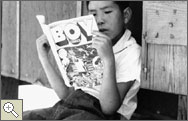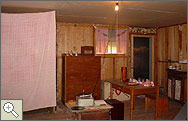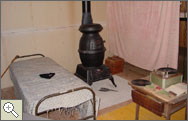
The internment program, conceived after the shock of Pearl Harbor, went forward after the U.S. victory at Midway in June 1942, which made a Japanese attack on the mainland virtually impossible. That summer, the civilian War Relocation Authority established ten permanent camps: Heart Mountain in Wyoming, Minidoka in Idaho, Topaz in Utah, Amache in Colorado, Tule Lake and Manzanar in inland California, Poston and Gila River in Arizona, and Rohwer and Jerome in Arkansas.
The living arrangements in these far-flung places were almost identical. Within tarpapered pine barracks, whole families lived in single rooms, some as small as twenty by twenty feet. None of the rooms had plumbing. Each block of barracks had a dining hall, a recreational hall, and buildings for showers and unpartitioned toilets.
Poston, located on an isolated tract of the Colorado River Indian Reservation, held some eighteen thousand people, which made it the third largest community in Arizona. It was actually a complex of three camps, which the internees nicknamed “Poston, Toastin’, and Roastin’.” Summer temperatures reached as high as 140 degrees.
What emerges in the Miss Breed letters, as in all other accounts of the internment, is the resourcefulness with which people brought a degree of normalcy and even grace to their new homes. In the Arizona desert, they planted flowers and raised their own crops. At one time, some three thousand acres were under cultivation.
Out of necessity, most of the men took up woodworking, using construction remnants or whatever else was at hand. Poston was only partially built when it opened, and so sparsely furnished that the schools had no desks. Students had to bring their own homemade chairs.
As Jeanne Wakatsuki Houston puts it in her memoir Farewell to Manzanar, each camp became, in time, “a totally equipped American small town, complete with schools, churches, Boy Scouts, beauty parlors, neighborhood gossip, fire and police departments, glee clubs, softball leagues, Abbott and Costello movies, tennis courts, and traveling shows.” The internment, she says, “did not change the kind of world we wanted.”
By January 1943, Louise Ogawa could write, “As time marches on, more and more Poston seems like home to me. After leaving home for a visit to Camp 1 or 2, it certainly feels good to be home again. No longer is the thought of being in a camp afloat in my mind. But every time I see the fence, it seems like a dark cloud has lifted and a realization of camp life comes before my eyes.”
|
 |
 |
 |

All I can say is the place certainly has improved since our coming in. There is much more greenery and it looks lived in.
-Fusa Tsumagari
|
 |
 |
 |
 |
 |
 |

Boy with Comic Book by Dorothea Lange (Manzanar, 1942).
|
 |
 |
 |
 |
 |
 |

Re-creation of divided room, from the exhibition A More Perfect Union.
|
 |
 |

Photo by T. Whitbread.
|
 |
 |
 |
 |
 |
 |

Re-creation of divided room, from the exhibition A More Perfect Union.
|
 |
 |

Photo by L. Safronova.
|
 |
 |
 |
|

